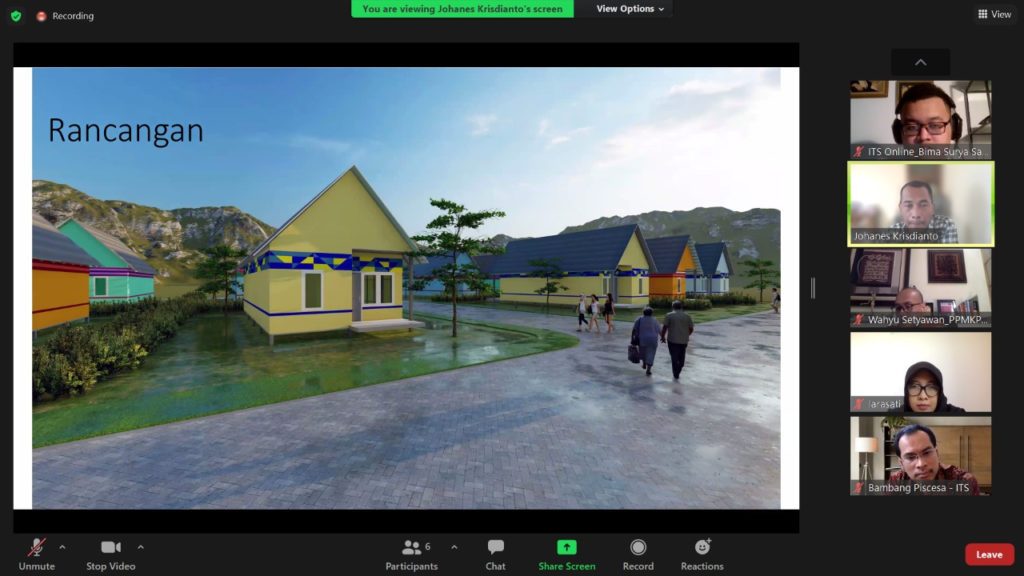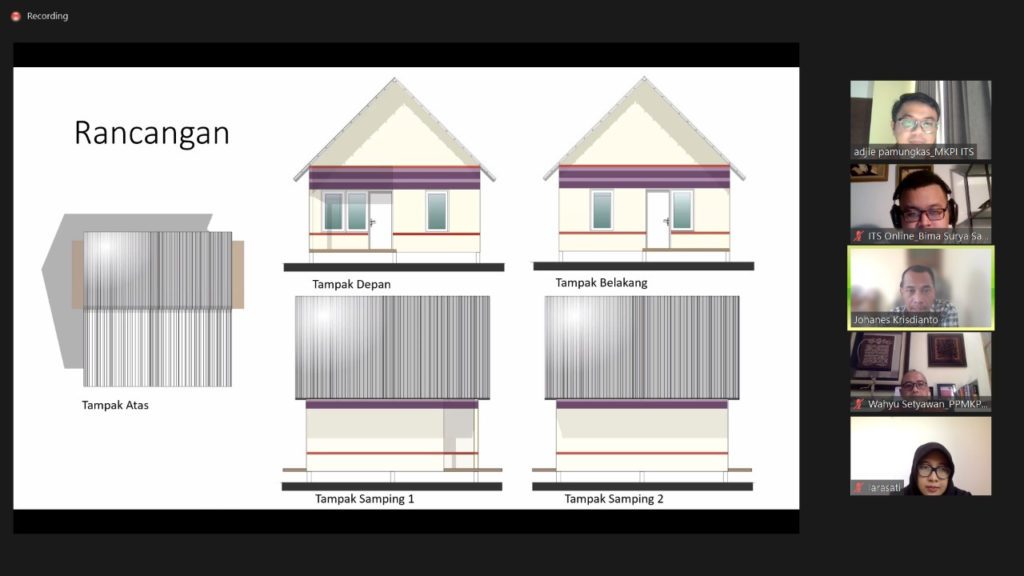Responding to Semeru, ITS Initiates the Hybrid Residential Concept

Presentation of the design simulation of a natural disaster-friendly house, the idea of the ITS research team
ITS Campus, ITS News – The Sepuluh Nopember Institute of Technology (ITS) continues to provide solutions for victims of the Mount Semeru eruption. This time, the ITS research team, especially from the ITS Mitigation, Disaster, and Climate Change Research Center (MKPI), formulated the hybrid concept of temporary shelter (huntara) and permanent shelter (huntap) after the Mount Semeru disaster.
This was discussed in an online discussion some time ago. Head of the ITS MKPI Research Center Adjie Pamungkas ST MDevPlg Ph.D. said that the debate aimed to provide solutions in the post-disaster resettlement of Mount Semeru.
This discussion was also attended by several researchers from ITS, including Johanes Krisdianto ST MT and Wahyu Setyawan ST MT from the Department of Architecture, Bambang Piscesa ST MT Ph.D. from the Department of Civil Engineering, and Kesumaning Dyah Larasati ST MArs as a research assistant at MKPI.
A hybrid concept of temporary housing (huntara) and permanent housing (huntap) was proposed in the discussion. This is done to avoid potential conflicts due to delays during shelters and shelters. In addition, the modular concept of an earthquake and volcanic ash resistance can also be applied to public facilities, such as village offices, schools, health centers, and so on.

The form of a house that is friendly to natural disasters initiated by the ITS team
According to Wahyu, village communities must be responsive and resilient to the dangers of disasters at the foot of Mount Semeru. Therefore, by implementing the resettlement concept, the village community at the foot of Mount Semeru is expected to participate in post-disaster recovery. “Starting from improving their economy, to increasing their knowledge about natural disaster mitigation,” he said.
Continuing the discussion, Johanes explained the concept of earthquake-resistant and volcanic ash houses. The house was formed with a roof that could withstand the outpouring of volcanic ash from the volcano. In addition, the house must be made of simple, sturdy, and easy-to-find materials in the Semeru area. “This is done to make it easier for rural communities to develop their houses independently without special skills,” he explained.
Not only that, the house conceptualized by the ITS team can be built quickly and can be moved easily. Therefore, Bambang believes that the materials must be light to be moved rapidly and not easily collapse when affected by the earthquake. “The house already has facilities according to core house standards, namely there are bathrooms, bedrooms, and kitchens,” he explained.
Another advantage, continued Adjie, is that the house is a hybrid, which means it can be a temporary residence, then the community can develop it into their permanent home. “The house can be reduced like a studio space or added to a wider house,” he added.
Wahyu also hopes that the construction of this settlement can be added by planting bamboo forests around the foot of Mount Semeru. “This bamboo planting can be an alarm for villagers because bamboo will make a loud sound when exposed to hot clouds,” he said.
It is hoped that this concept can be realized soon. Thus, houses built in the future can be more friendly to natural disasters, especially in the area at the foot of Mount Semeru. “We hope the house can be more resilient and not easily collapse,” said Bambang hopefully. (ITS Public Relation/far)
Reporter: Bima Surya Samudra
Related News
-
ITS Wins 2024 Project Implementation Award for Commitment to Gender Implementation
ITS Campus, ITS News —Not only technology-oriented, Institut Teknologi Sepuluh Nopember (ITS) also show its commitment to support gender
December 27, 2021 16:12 -
ITS Professor Researched the Role of Human Integration in Sustainable Architecture
ITS Campus, ITS News –The developing era has an impact on many aspects of life, including in the field
December 27, 2021 16:12 -
ITS Sends Off Group for Joint Homecoming to 64 Destination Areas
ITS Campus, ITS News — Approaching Eid al-Fitr, the Sepuluh Nopember Institute of Technology (ITS) is once again facilitating academics who want
December 27, 2021 16:12 -
ITS Expert: IHSG Decline Has Significant Impact on Indonesian Economy
ITS Campus, ITS News — The decline in the Composite Stock Price Index (IHSG) by five percent on March 18,
December 27, 2021 16:12
